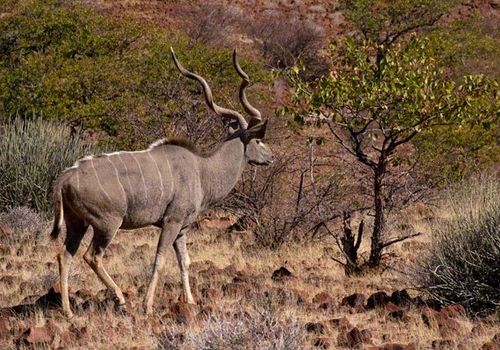
Kudu
Tragelaphus strepsicerosKudu
Introduction: The greater kudu (Tragelaphus strepsiceros) is found throughout central & northern Namibia and is the second tallest antelope on the African continent. Kudu bulls bear long, spiral horns which reach record lengths of up to 1.8m. Horns grow to their full length at the age of six years. Kudu live in small herds not usually larger than twelve, comprising of females and their young. During the breeding season, the herds are occasionally joined by the normally solitary males.
They are a savannah woodland species that do not occur in desert, forest or in open grassland areas. Kudu can also be found in broken, rocky terrain, under the cover of woodland with a nearby water supply. Despite their large size, kudu are surprisingly agile and from a virtual standing start can jump great heights, easily clearing game fences of 2m or more.
Distribution: Kudu are found on commercial farmland and in game parks all over central Namibia. They are an extreme hazard to those driving at night as they often freeze in oncoming headlights. Such a large solid animal (with massive horns) can do serious damage. Particular care should be taken when driving north out of Windhoek towards Tsumeb and the Etosha National Park.
Diet: The kudu is predominately a browser. This species feeds on a wide variety of tree and shrub leaves, favouring fruits, pods and creepers when available.
Colouring: Tawny-brown to grey-brown coat, marked with white stripes on flanks which vary greatly in shape, size and pattern. V-shaped band on forehead and white spots on cheeks. Manes of long hair extend from the back of the head along the back to the tail, as well as on the lower neck to the belly.
Breeding: The main calving period falls after mid-summer, when the grass is tallest. This gives females the opportunity to drift away from the herd to give birth under cover. Gestation period is 210 days and a single calf is born.
Size: Bulls are much larger than cows and can weigh as much as 300kg, with a shoulder height of 1.4m. Cows weigh 210kg with a shoulder height of 1.25m. Usually it is only the males who carry horns, but sometimes the females do.
Klein Windhoek

